M&S Business Resource Management
VerifiedAdded on 2020/01/07
|13
|4444
|262
Report
AI Summary
This report analyzes Marks & Spencer's (M&S) business resource management, focusing on human resources, physical resources, technological resources, and financial capital. It examines recruitment documentation, the importance of employability and communication skills, and the physical and technological resources used in M&S operations. The report delves into internal and external finance sources, the contents of trading, profit and loss accounts, and balance sheets. Budgeting and financial control mechanisms are evaluated, along with an analysis of accounting ratios and the problems arising from unmonitored costs and budgets. The report concludes by summarizing M&S's resource management effectiveness and its financial performance based on the analyzed data.
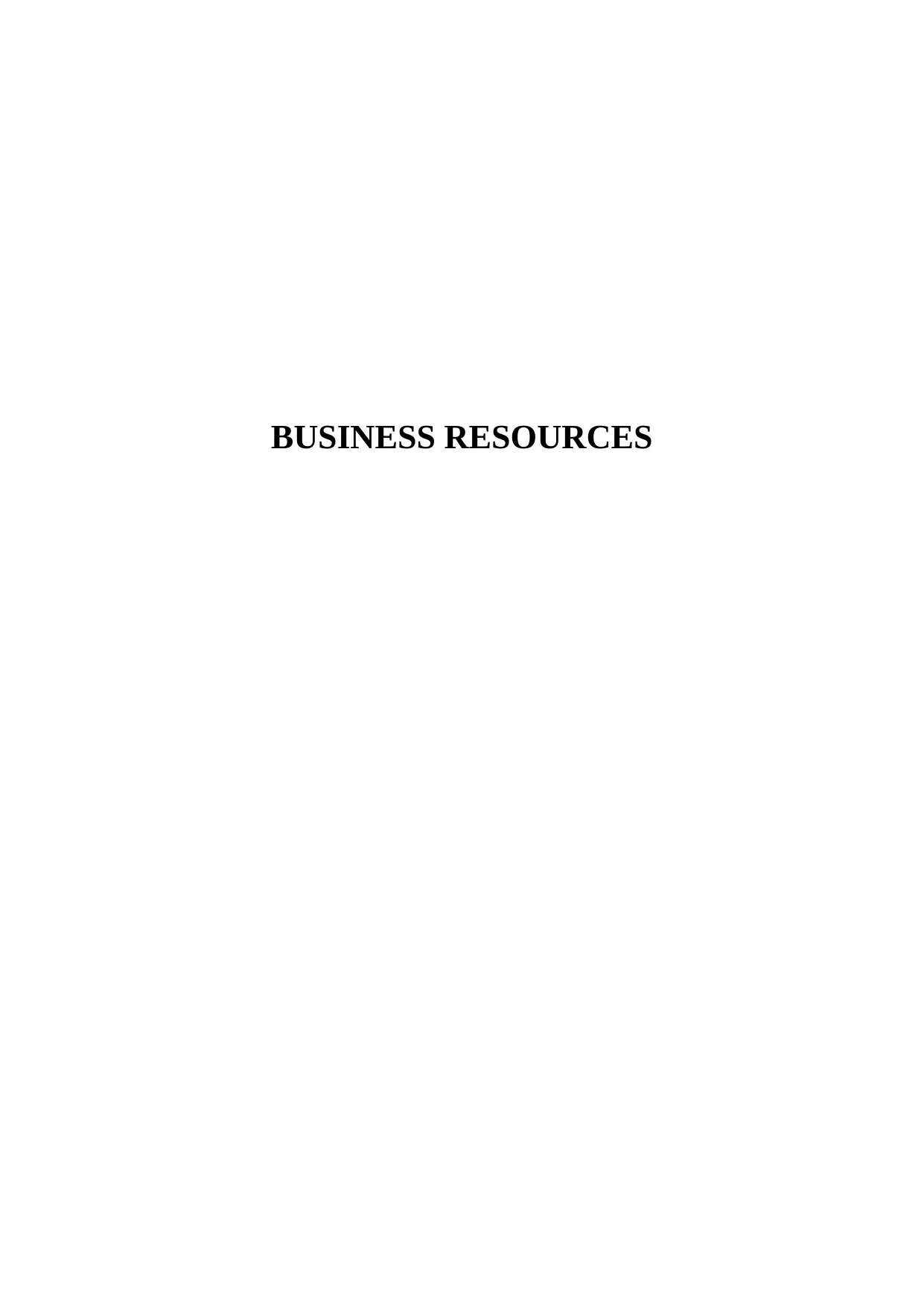
BUSINESS RESOURCES
Paraphrase This Document
Need a fresh take? Get an instant paraphrase of this document with our AI Paraphraser
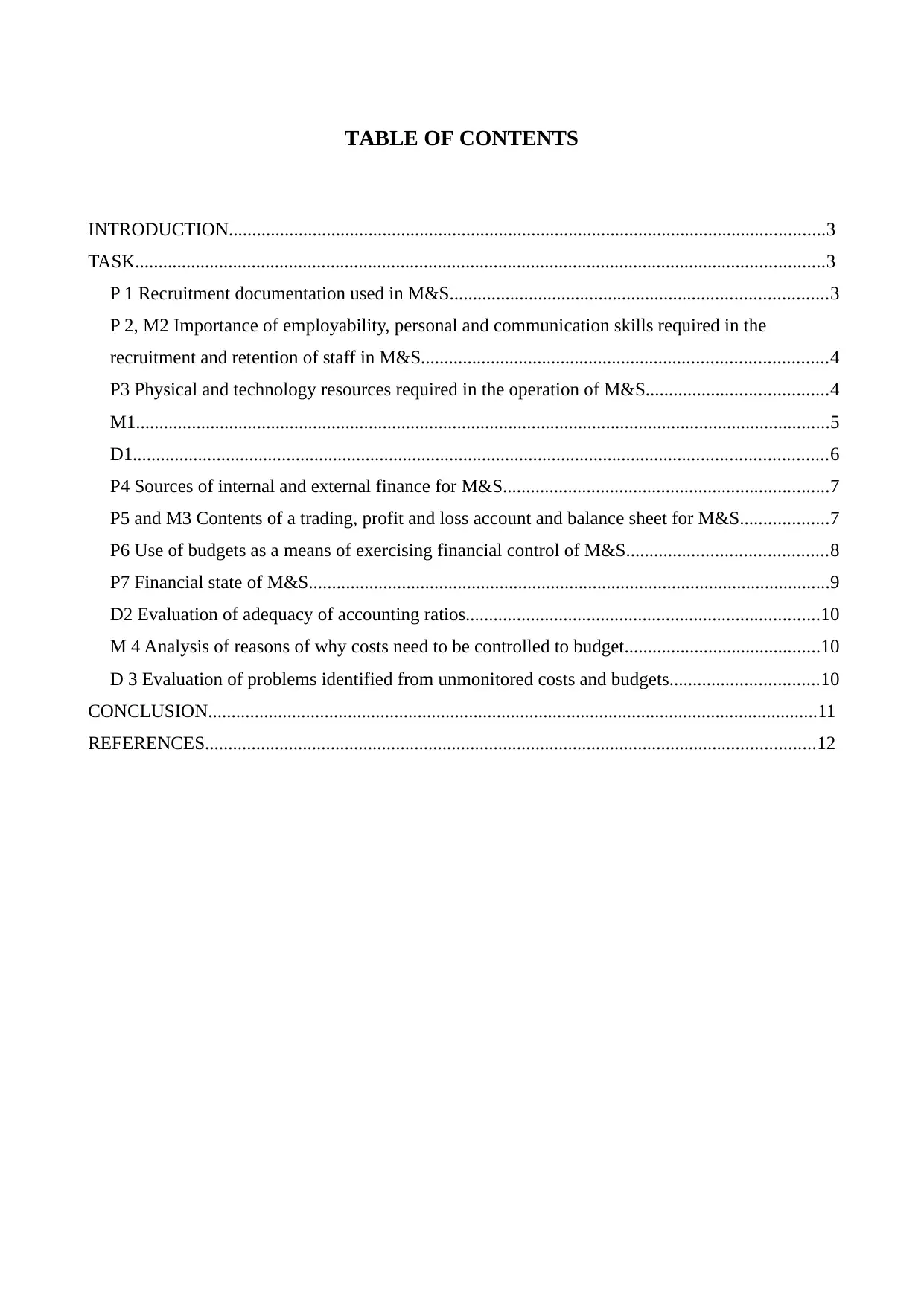
TABLE OF CONTENTS
INTRODUCTION................................................................................................................................3
TASK....................................................................................................................................................3
P 1 Recruitment documentation used in M&S.................................................................................3
P 2, M2 Importance of employability, personal and communication skills required in the
recruitment and retention of staff in M&S.......................................................................................4
P3 Physical and technology resources required in the operation of M&S.......................................4
M1.....................................................................................................................................................5
D1.....................................................................................................................................................6
P4 Sources of internal and external finance for M&S......................................................................7
P5 and M3 Contents of a trading, profit and loss account and balance sheet for M&S...................7
P6 Use of budgets as a means of exercising financial control of M&S...........................................8
P7 Financial state of M&S................................................................................................................9
D2 Evaluation of adequacy of accounting ratios............................................................................10
M 4 Analysis of reasons of why costs need to be controlled to budget..........................................10
D 3 Evaluation of problems identified from unmonitored costs and budgets................................10
CONCLUSION...................................................................................................................................11
REFERENCES...................................................................................................................................12
INTRODUCTION................................................................................................................................3
TASK....................................................................................................................................................3
P 1 Recruitment documentation used in M&S.................................................................................3
P 2, M2 Importance of employability, personal and communication skills required in the
recruitment and retention of staff in M&S.......................................................................................4
P3 Physical and technology resources required in the operation of M&S.......................................4
M1.....................................................................................................................................................5
D1.....................................................................................................................................................6
P4 Sources of internal and external finance for M&S......................................................................7
P5 and M3 Contents of a trading, profit and loss account and balance sheet for M&S...................7
P6 Use of budgets as a means of exercising financial control of M&S...........................................8
P7 Financial state of M&S................................................................................................................9
D2 Evaluation of adequacy of accounting ratios............................................................................10
M 4 Analysis of reasons of why costs need to be controlled to budget..........................................10
D 3 Evaluation of problems identified from unmonitored costs and budgets................................10
CONCLUSION...................................................................................................................................11
REFERENCES...................................................................................................................................12
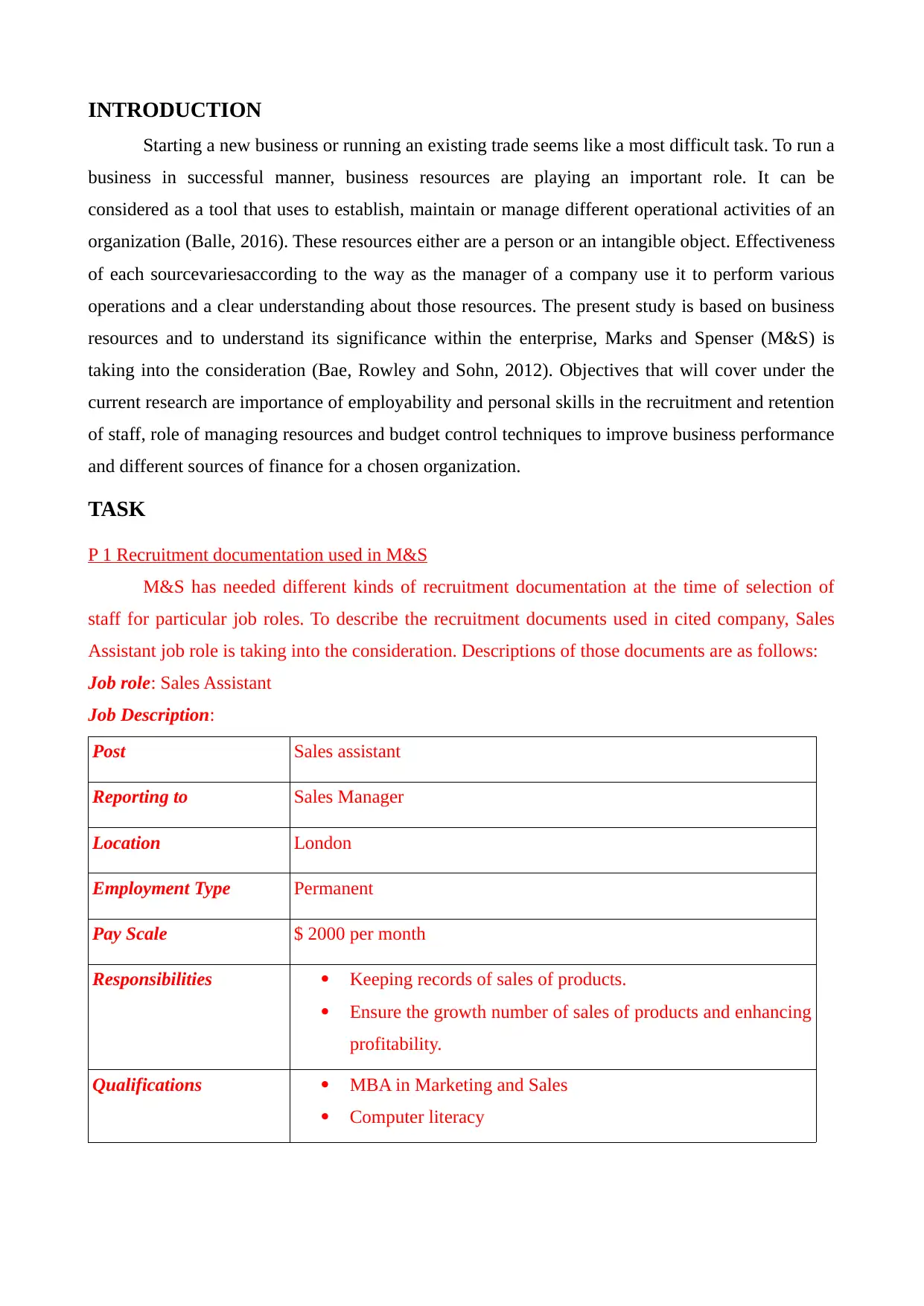
INTRODUCTION
Starting a new business or running an existing trade seems like a most difficult task. To run a
business in successful manner, business resources are playing an important role. It can be
considered as a tool that uses to establish, maintain or manage different operational activities of an
organization (Balle, 2016). These resources either are a person or an intangible object. Effectiveness
of each sourcevariesaccording to the way as the manager of a company use it to perform various
operations and a clear understanding about those resources. The present study is based on business
resources and to understand its significance within the enterprise, Marks and Spenser (M&S) is
taking into the consideration (Bae, Rowley and Sohn, 2012). Objectives that will cover under the
current research are importance of employability and personal skills in the recruitment and retention
of staff, role of managing resources and budget control techniques to improve business performance
and different sources of finance for a chosen organization.
TASK
P 1 Recruitment documentation used in M&S
M&S has needed different kinds of recruitment documentation at the time of selection of
staff for particular job roles. To describe the recruitment documents used in cited company, Sales
Assistant job role is taking into the consideration. Descriptions of those documents are as follows:
Job role: Sales Assistant
Job Description:
Post Sales assistant
Reporting to Sales Manager
Location London
Employment Type Permanent
Pay Scale $ 2000 per month
Responsibilities Keeping records of sales of products.
Ensure the growth number of sales of products and enhancing
profitability.
Qualifications MBA in Marketing and Sales
Computer literacy
Starting a new business or running an existing trade seems like a most difficult task. To run a
business in successful manner, business resources are playing an important role. It can be
considered as a tool that uses to establish, maintain or manage different operational activities of an
organization (Balle, 2016). These resources either are a person or an intangible object. Effectiveness
of each sourcevariesaccording to the way as the manager of a company use it to perform various
operations and a clear understanding about those resources. The present study is based on business
resources and to understand its significance within the enterprise, Marks and Spenser (M&S) is
taking into the consideration (Bae, Rowley and Sohn, 2012). Objectives that will cover under the
current research are importance of employability and personal skills in the recruitment and retention
of staff, role of managing resources and budget control techniques to improve business performance
and different sources of finance for a chosen organization.
TASK
P 1 Recruitment documentation used in M&S
M&S has needed different kinds of recruitment documentation at the time of selection of
staff for particular job roles. To describe the recruitment documents used in cited company, Sales
Assistant job role is taking into the consideration. Descriptions of those documents are as follows:
Job role: Sales Assistant
Job Description:
Post Sales assistant
Reporting to Sales Manager
Location London
Employment Type Permanent
Pay Scale $ 2000 per month
Responsibilities Keeping records of sales of products.
Ensure the growth number of sales of products and enhancing
profitability.
Qualifications MBA in Marketing and Sales
Computer literacy
⊘ This is a preview!⊘
Do you want full access?
Subscribe today to unlock all pages.

Trusted by 1+ million students worldwide
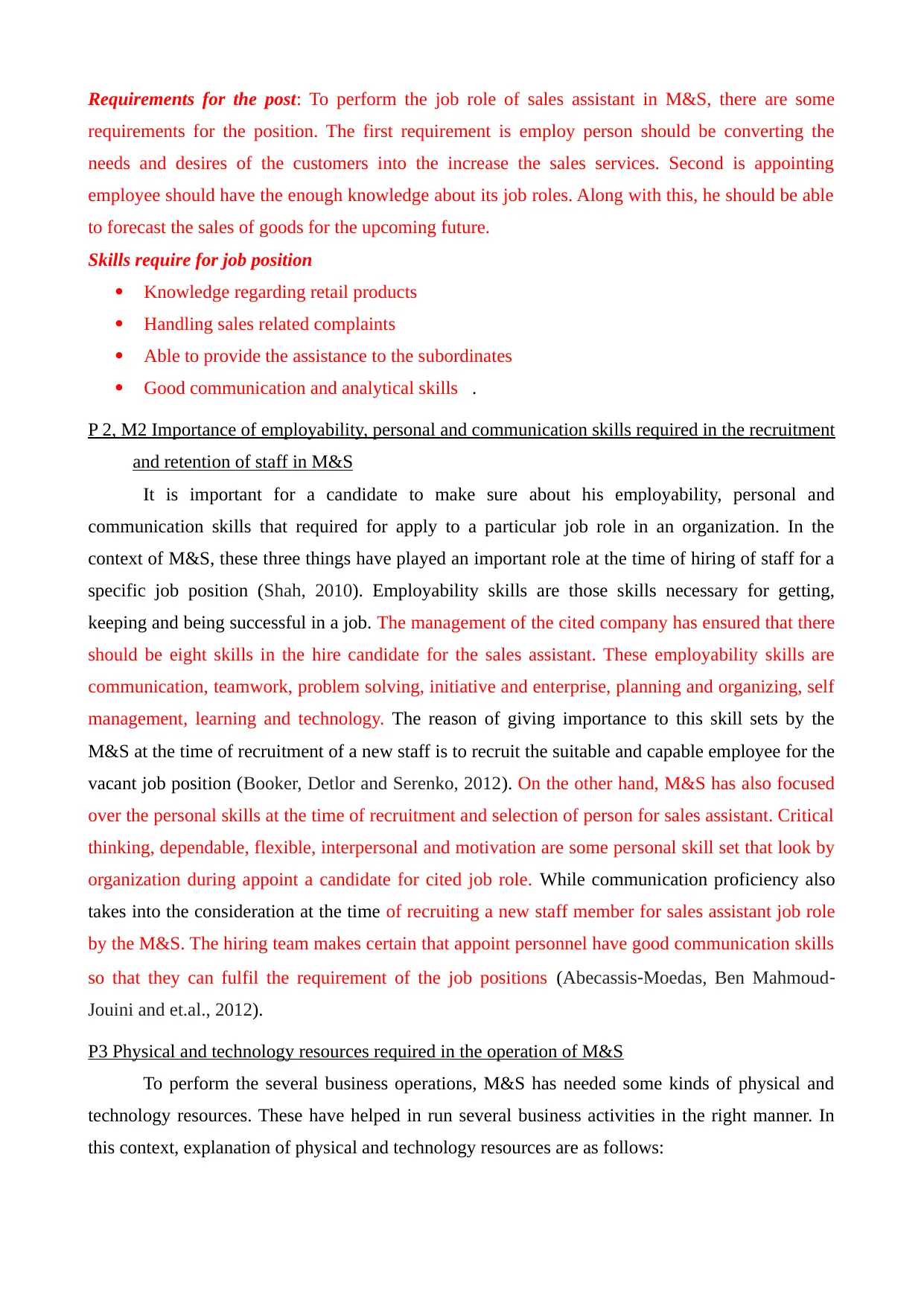
Requirements for the post: To perform the job role of sales assistant in M&S, there are some
requirements for the position. The first requirement is employ person should be converting the
needs and desires of the customers into the increase the sales services. Second is appointing
employee should have the enough knowledge about its job roles. Along with this, he should be able
to forecast the sales of goods for the upcoming future.
Skills require for job position
Knowledge regarding retail products
Handling sales related complaints
Able to provide the assistance to the subordinates
Good communication and analytical skills .
P 2, M2 Importance of employability, personal and communication skills required in the recruitment
and retention of staff in M&S
It is important for a candidate to make sure about his employability, personal and
communication skills that required for apply to a particular job role in an organization. In the
context of M&S, these three things have played an important role at the time of hiring of staff for a
specific job position (Shah, 2010). Employability skills are those skills necessary for getting,
keeping and being successful in a job. The management of the cited company has ensured that there
should be eight skills in the hire candidate for the sales assistant. These employability skills are
communication, teamwork, problem solving, initiative and enterprise, planning and organizing, self
management, learning and technology. The reason of giving importance to this skill sets by the
M&S at the time of recruitment of a new staff is to recruit the suitable and capable employee for the
vacant job position (Booker, Detlor and Serenko, 2012). On the other hand, M&S has also focused
over the personal skills at the time of recruitment and selection of person for sales assistant. Critical
thinking, dependable, flexible, interpersonal and motivation are some personal skill set that look by
organization during appoint a candidate for cited job role. While communication proficiency also
takes into the consideration at the time of recruiting a new staff member for sales assistant job role
by the M&S. The hiring team makes certain that appoint personnel have good communication skills
so that they can fulfil the requirement of the job positions (Abecassis‐Moedas, Ben Mahmoud‐
Jouini and et.al., 2012).
P3 Physical and technology resources required in the operation of M&S
To perform the several business operations, M&S has needed some kinds of physical and
technology resources. These have helped in run several business activities in the right manner. In
this context, explanation of physical and technology resources are as follows:
requirements for the position. The first requirement is employ person should be converting the
needs and desires of the customers into the increase the sales services. Second is appointing
employee should have the enough knowledge about its job roles. Along with this, he should be able
to forecast the sales of goods for the upcoming future.
Skills require for job position
Knowledge regarding retail products
Handling sales related complaints
Able to provide the assistance to the subordinates
Good communication and analytical skills .
P 2, M2 Importance of employability, personal and communication skills required in the recruitment
and retention of staff in M&S
It is important for a candidate to make sure about his employability, personal and
communication skills that required for apply to a particular job role in an organization. In the
context of M&S, these three things have played an important role at the time of hiring of staff for a
specific job position (Shah, 2010). Employability skills are those skills necessary for getting,
keeping and being successful in a job. The management of the cited company has ensured that there
should be eight skills in the hire candidate for the sales assistant. These employability skills are
communication, teamwork, problem solving, initiative and enterprise, planning and organizing, self
management, learning and technology. The reason of giving importance to this skill sets by the
M&S at the time of recruitment of a new staff is to recruit the suitable and capable employee for the
vacant job position (Booker, Detlor and Serenko, 2012). On the other hand, M&S has also focused
over the personal skills at the time of recruitment and selection of person for sales assistant. Critical
thinking, dependable, flexible, interpersonal and motivation are some personal skill set that look by
organization during appoint a candidate for cited job role. While communication proficiency also
takes into the consideration at the time of recruiting a new staff member for sales assistant job role
by the M&S. The hiring team makes certain that appoint personnel have good communication skills
so that they can fulfil the requirement of the job positions (Abecassis‐Moedas, Ben Mahmoud‐
Jouini and et.al., 2012).
P3 Physical and technology resources required in the operation of M&S
To perform the several business operations, M&S has needed some kinds of physical and
technology resources. These have helped in run several business activities in the right manner. In
this context, explanation of physical and technology resources are as follows:
Paraphrase This Document
Need a fresh take? Get an instant paraphrase of this document with our AI Paraphraser
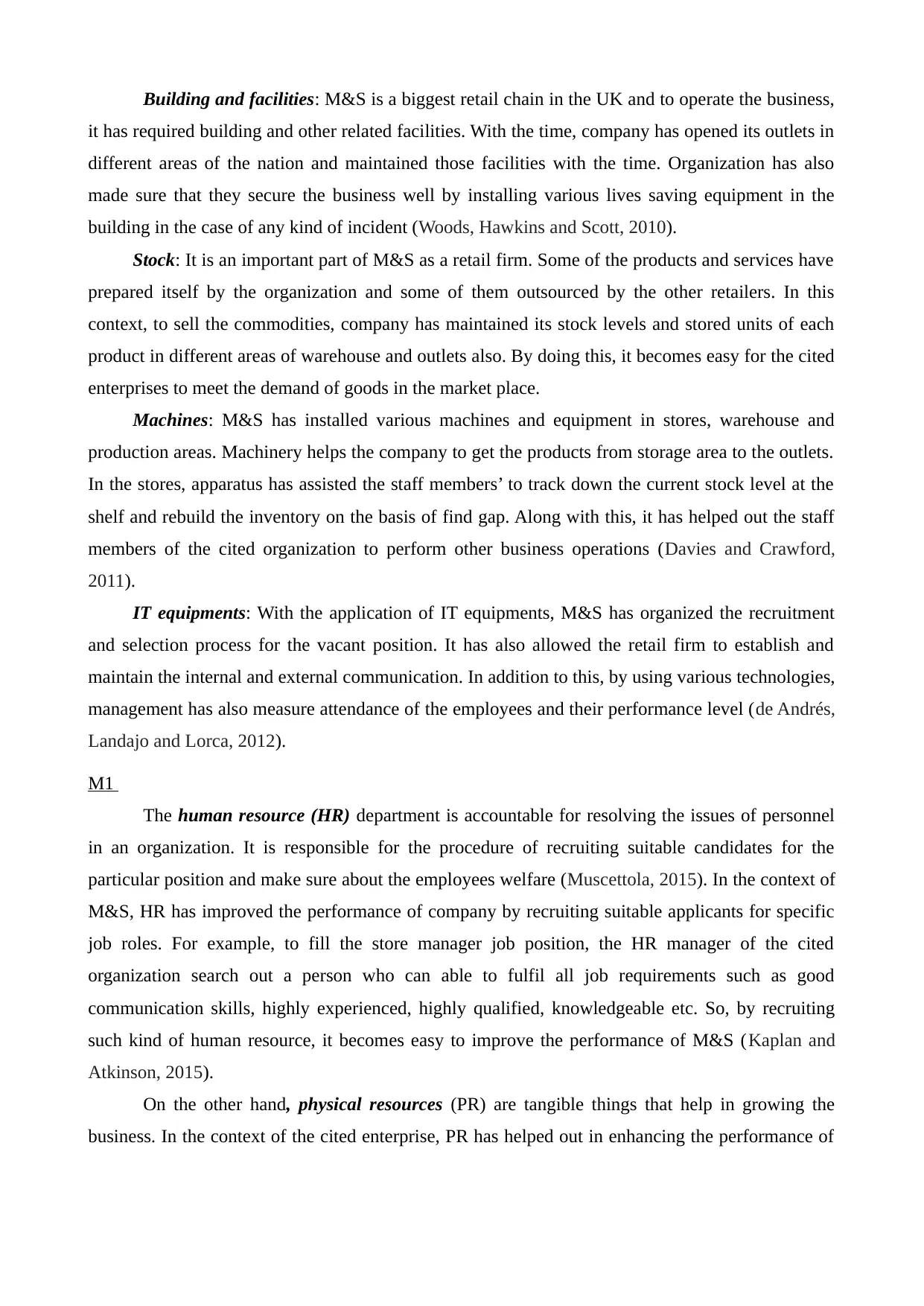
Building and facilities: M&S is a biggest retail chain in the UK and to operate the business,
it has required building and other related facilities. With the time, company has opened its outlets in
different areas of the nation and maintained those facilities with the time. Organization has also
made sure that they secure the business well by installing various lives saving equipment in the
building in the case of any kind of incident (Woods, Hawkins and Scott, 2010).
Stock: It is an important part of M&S as a retail firm. Some of the products and services have
prepared itself by the organization and some of them outsourced by the other retailers. In this
context, to sell the commodities, company has maintained its stock levels and stored units of each
product in different areas of warehouse and outlets also. By doing this, it becomes easy for the cited
enterprises to meet the demand of goods in the market place.
Machines: M&S has installed various machines and equipment in stores, warehouse and
production areas. Machinery helps the company to get the products from storage area to the outlets.
In the stores, apparatus has assisted the staff members’ to track down the current stock level at the
shelf and rebuild the inventory on the basis of find gap. Along with this, it has helped out the staff
members of the cited organization to perform other business operations (Davies and Crawford,
2011).
IT equipments: With the application of IT equipments, M&S has organized the recruitment
and selection process for the vacant position. It has also allowed the retail firm to establish and
maintain the internal and external communication. In addition to this, by using various technologies,
management has also measure attendance of the employees and their performance level (de Andrés,
Landajo and Lorca, 2012).
M1
The human resource (HR) department is accountable for resolving the issues of personnel
in an organization. It is responsible for the procedure of recruiting suitable candidates for the
particular position and make sure about the employees welfare (Muscettola, 2015). In the context of
M&S, HR has improved the performance of company by recruiting suitable applicants for specific
job roles. For example, to fill the store manager job position, the HR manager of the cited
organization search out a person who can able to fulfil all job requirements such as good
communication skills, highly experienced, highly qualified, knowledgeable etc. So, by recruiting
such kind of human resource, it becomes easy to improve the performance of M&S (Kaplan and
Atkinson, 2015).
On the other hand, physical resources (PR) are tangible things that help in growing the
business. In the context of the cited enterprise, PR has helped out in enhancing the performance of
it has required building and other related facilities. With the time, company has opened its outlets in
different areas of the nation and maintained those facilities with the time. Organization has also
made sure that they secure the business well by installing various lives saving equipment in the
building in the case of any kind of incident (Woods, Hawkins and Scott, 2010).
Stock: It is an important part of M&S as a retail firm. Some of the products and services have
prepared itself by the organization and some of them outsourced by the other retailers. In this
context, to sell the commodities, company has maintained its stock levels and stored units of each
product in different areas of warehouse and outlets also. By doing this, it becomes easy for the cited
enterprises to meet the demand of goods in the market place.
Machines: M&S has installed various machines and equipment in stores, warehouse and
production areas. Machinery helps the company to get the products from storage area to the outlets.
In the stores, apparatus has assisted the staff members’ to track down the current stock level at the
shelf and rebuild the inventory on the basis of find gap. Along with this, it has helped out the staff
members of the cited organization to perform other business operations (Davies and Crawford,
2011).
IT equipments: With the application of IT equipments, M&S has organized the recruitment
and selection process for the vacant position. It has also allowed the retail firm to establish and
maintain the internal and external communication. In addition to this, by using various technologies,
management has also measure attendance of the employees and their performance level (de Andrés,
Landajo and Lorca, 2012).
M1
The human resource (HR) department is accountable for resolving the issues of personnel
in an organization. It is responsible for the procedure of recruiting suitable candidates for the
particular position and make sure about the employees welfare (Muscettola, 2015). In the context of
M&S, HR has improved the performance of company by recruiting suitable applicants for specific
job roles. For example, to fill the store manager job position, the HR manager of the cited
organization search out a person who can able to fulfil all job requirements such as good
communication skills, highly experienced, highly qualified, knowledgeable etc. So, by recruiting
such kind of human resource, it becomes easy to improve the performance of M&S (Kaplan and
Atkinson, 2015).
On the other hand, physical resources (PR) are tangible things that help in growing the
business. In the context of the cited enterprise, PR has helped out in enhancing the performance of
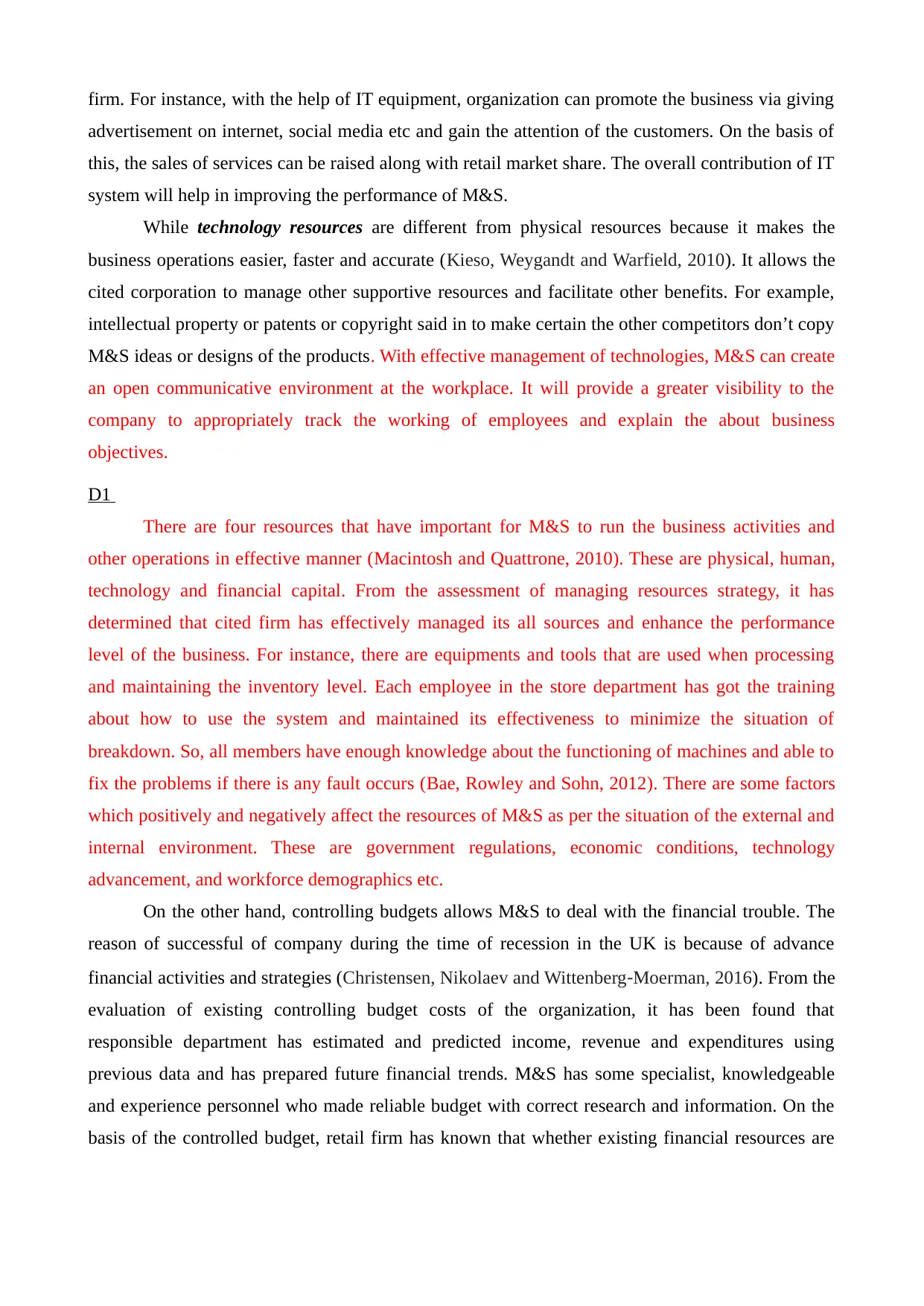
firm. For instance, with the help of IT equipment, organization can promote the business via giving
advertisement on internet, social media etc and gain the attention of the customers. On the basis of
this, the sales of services can be raised along with retail market share. The overall contribution of IT
system will help in improving the performance of M&S.
While technology resources are different from physical resources because it makes the
business operations easier, faster and accurate (Kieso, Weygandt and Warfield, 2010). It allows the
cited corporation to manage other supportive resources and facilitate other benefits. For example,
intellectual property or patents or copyright said in to make certain the other competitors don’t copy
M&S ideas or designs of the products. With effective management of technologies, M&S can create
an open communicative environment at the workplace. It will provide a greater visibility to the
company to appropriately track the working of employees and explain the about business
objectives.
D1
There are four resources that have important for M&S to run the business activities and
other operations in effective manner (Macintosh and Quattrone, 2010). These are physical, human,
technology and financial capital. From the assessment of managing resources strategy, it has
determined that cited firm has effectively managed its all sources and enhance the performance
level of the business. For instance, there are equipments and tools that are used when processing
and maintaining the inventory level. Each employee in the store department has got the training
about how to use the system and maintained its effectiveness to minimize the situation of
breakdown. So, all members have enough knowledge about the functioning of machines and able to
fix the problems if there is any fault occurs (Bae, Rowley and Sohn, 2012). There are some factors
which positively and negatively affect the resources of M&S as per the situation of the external and
internal environment. These are government regulations, economic conditions, technology
advancement, and workforce demographics etc.
On the other hand, controlling budgets allows M&S to deal with the financial trouble. The
reason of successful of company during the time of recession in the UK is because of advance
financial activities and strategies (Christensen, Nikolaev and Wittenberg‐Moerman, 2016). From the
evaluation of existing controlling budget costs of the organization, it has been found that
responsible department has estimated and predicted income, revenue and expenditures using
previous data and has prepared future financial trends. M&S has some specialist, knowledgeable
and experience personnel who made reliable budget with correct research and information. On the
basis of the controlled budget, retail firm has known that whether existing financial resources are
advertisement on internet, social media etc and gain the attention of the customers. On the basis of
this, the sales of services can be raised along with retail market share. The overall contribution of IT
system will help in improving the performance of M&S.
While technology resources are different from physical resources because it makes the
business operations easier, faster and accurate (Kieso, Weygandt and Warfield, 2010). It allows the
cited corporation to manage other supportive resources and facilitate other benefits. For example,
intellectual property or patents or copyright said in to make certain the other competitors don’t copy
M&S ideas or designs of the products. With effective management of technologies, M&S can create
an open communicative environment at the workplace. It will provide a greater visibility to the
company to appropriately track the working of employees and explain the about business
objectives.
D1
There are four resources that have important for M&S to run the business activities and
other operations in effective manner (Macintosh and Quattrone, 2010). These are physical, human,
technology and financial capital. From the assessment of managing resources strategy, it has
determined that cited firm has effectively managed its all sources and enhance the performance
level of the business. For instance, there are equipments and tools that are used when processing
and maintaining the inventory level. Each employee in the store department has got the training
about how to use the system and maintained its effectiveness to minimize the situation of
breakdown. So, all members have enough knowledge about the functioning of machines and able to
fix the problems if there is any fault occurs (Bae, Rowley and Sohn, 2012). There are some factors
which positively and negatively affect the resources of M&S as per the situation of the external and
internal environment. These are government regulations, economic conditions, technology
advancement, and workforce demographics etc.
On the other hand, controlling budgets allows M&S to deal with the financial trouble. The
reason of successful of company during the time of recession in the UK is because of advance
financial activities and strategies (Christensen, Nikolaev and Wittenberg‐Moerman, 2016). From the
evaluation of existing controlling budget costs of the organization, it has been found that
responsible department has estimated and predicted income, revenue and expenditures using
previous data and has prepared future financial trends. M&S has some specialist, knowledgeable
and experience personnel who made reliable budget with correct research and information. On the
basis of the controlled budget, retail firm has known that whether existing financial resources are
⊘ This is a preview!⊘
Do you want full access?
Subscribe today to unlock all pages.

Trusted by 1+ million students worldwide
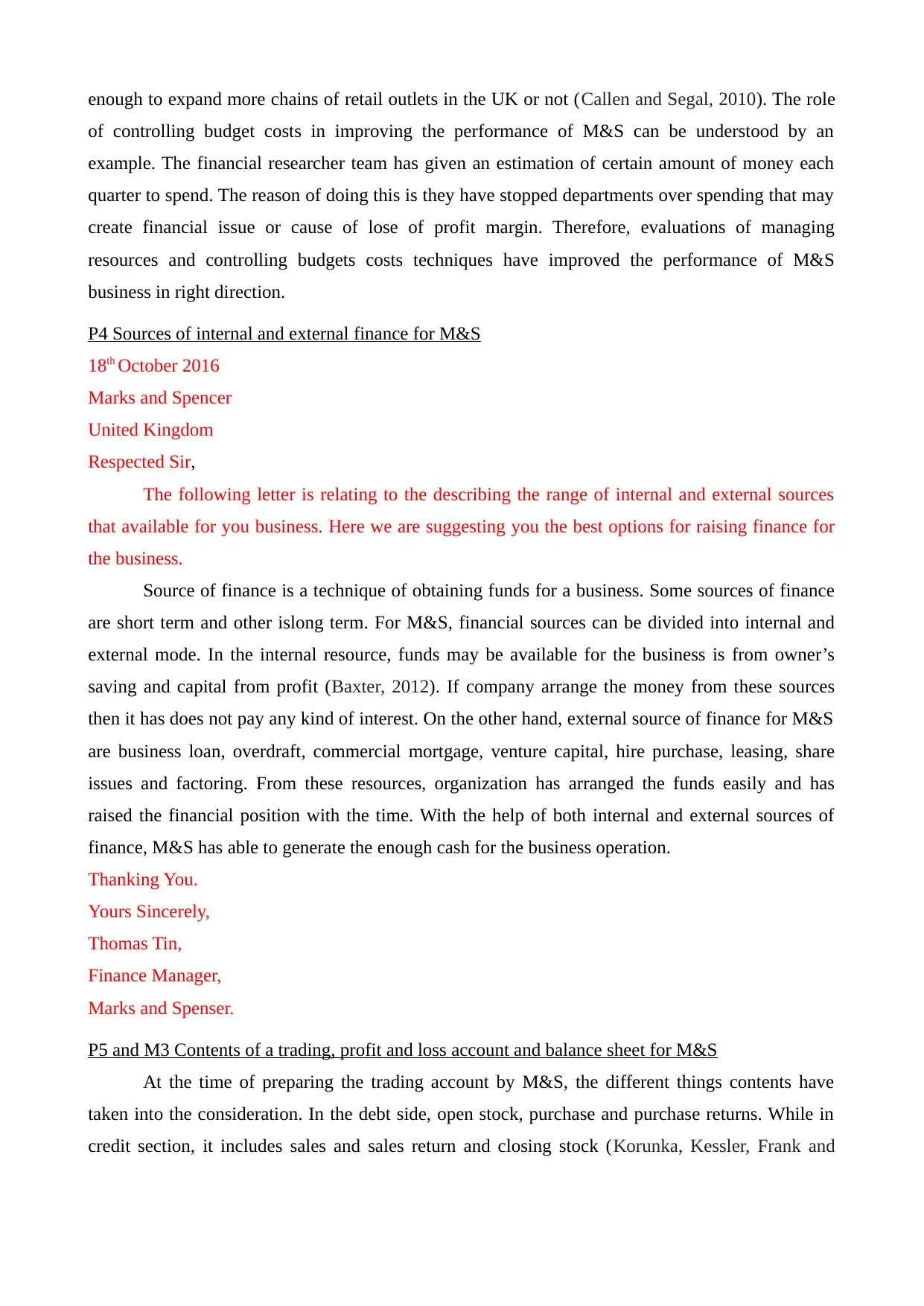
enough to expand more chains of retail outlets in the UK or not (Callen and Segal, 2010). The role
of controlling budget costs in improving the performance of M&S can be understood by an
example. The financial researcher team has given an estimation of certain amount of money each
quarter to spend. The reason of doing this is they have stopped departments over spending that may
create financial issue or cause of lose of profit margin. Therefore, evaluations of managing
resources and controlling budgets costs techniques have improved the performance of M&S
business in right direction.
P4 Sources of internal and external finance for M&S
18th October 2016
Marks and Spencer
United Kingdom
Respected Sir,
The following letter is relating to the describing the range of internal and external sources
that available for you business. Here we are suggesting you the best options for raising finance for
the business.
Source of finance is a technique of obtaining funds for a business. Some sources of finance
are short term and other islong term. For M&S, financial sources can be divided into internal and
external mode. In the internal resource, funds may be available for the business is from owner’s
saving and capital from profit (Baxter, 2012). If company arrange the money from these sources
then it has does not pay any kind of interest. On the other hand, external source of finance for M&S
are business loan, overdraft, commercial mortgage, venture capital, hire purchase, leasing, share
issues and factoring. From these resources, organization has arranged the funds easily and has
raised the financial position with the time. With the help of both internal and external sources of
finance, M&S has able to generate the enough cash for the business operation.
Thanking You.
Yours Sincerely,
Thomas Tin,
Finance Manager,
Marks and Spenser.
P5 and M3 Contents of a trading, profit and loss account and balance sheet for M&S
At the time of preparing the trading account by M&S, the different things contents have
taken into the consideration. In the debt side, open stock, purchase and purchase returns. While in
credit section, it includes sales and sales return and closing stock (Korunka, Kessler, Frank and
of controlling budget costs in improving the performance of M&S can be understood by an
example. The financial researcher team has given an estimation of certain amount of money each
quarter to spend. The reason of doing this is they have stopped departments over spending that may
create financial issue or cause of lose of profit margin. Therefore, evaluations of managing
resources and controlling budgets costs techniques have improved the performance of M&S
business in right direction.
P4 Sources of internal and external finance for M&S
18th October 2016
Marks and Spencer
United Kingdom
Respected Sir,
The following letter is relating to the describing the range of internal and external sources
that available for you business. Here we are suggesting you the best options for raising finance for
the business.
Source of finance is a technique of obtaining funds for a business. Some sources of finance
are short term and other islong term. For M&S, financial sources can be divided into internal and
external mode. In the internal resource, funds may be available for the business is from owner’s
saving and capital from profit (Baxter, 2012). If company arrange the money from these sources
then it has does not pay any kind of interest. On the other hand, external source of finance for M&S
are business loan, overdraft, commercial mortgage, venture capital, hire purchase, leasing, share
issues and factoring. From these resources, organization has arranged the funds easily and has
raised the financial position with the time. With the help of both internal and external sources of
finance, M&S has able to generate the enough cash for the business operation.
Thanking You.
Yours Sincerely,
Thomas Tin,
Finance Manager,
Marks and Spenser.
P5 and M3 Contents of a trading, profit and loss account and balance sheet for M&S
At the time of preparing the trading account by M&S, the different things contents have
taken into the consideration. In the debt side, open stock, purchase and purchase returns. While in
credit section, it includes sales and sales return and closing stock (Korunka, Kessler, Frank and
Paraphrase This Document
Need a fresh take? Get an instant paraphrase of this document with our AI Paraphraser
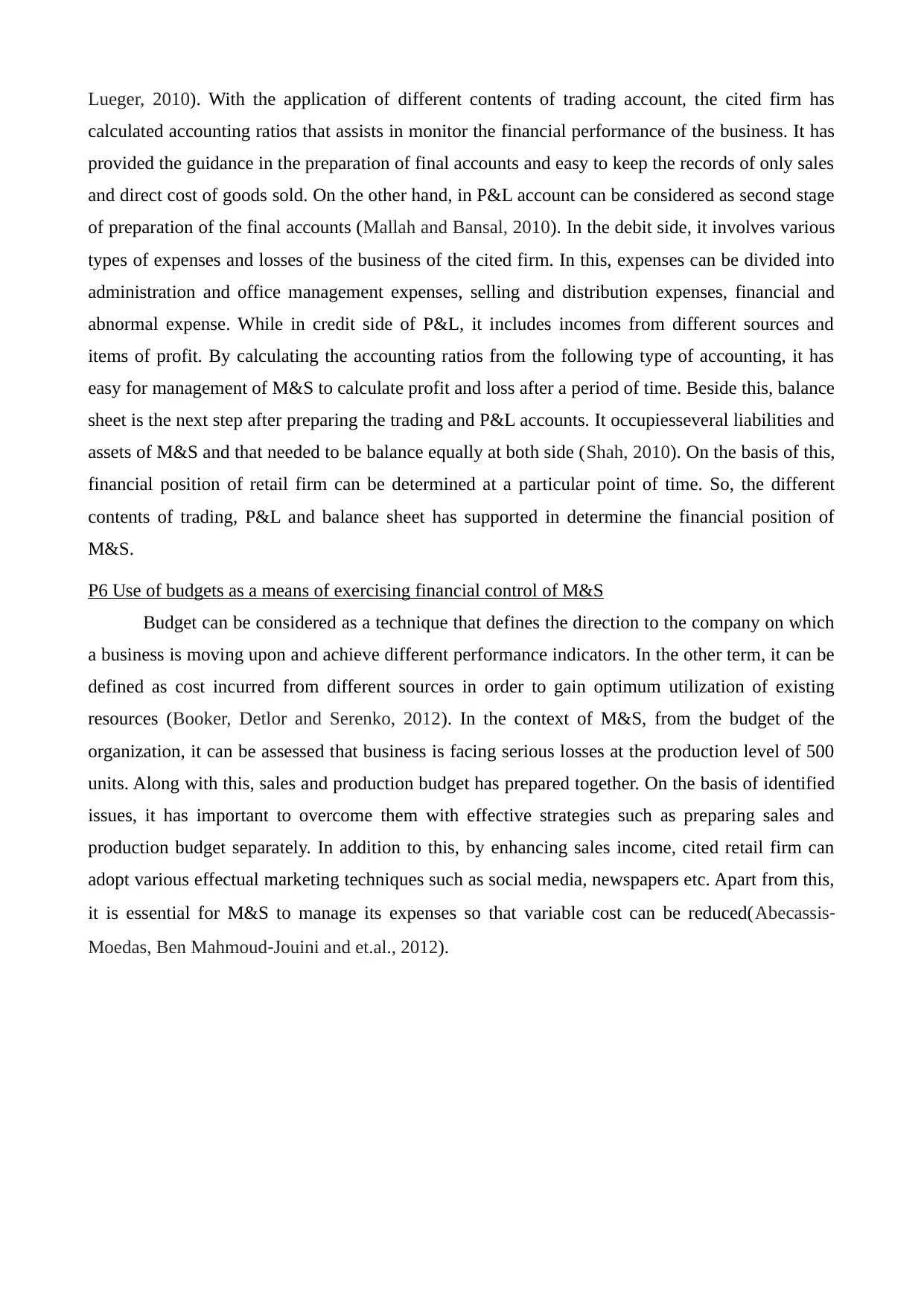
Lueger, 2010). With the application of different contents of trading account, the cited firm has
calculated accounting ratios that assists in monitor the financial performance of the business. It has
provided the guidance in the preparation of final accounts and easy to keep the records of only sales
and direct cost of goods sold. On the other hand, in P&L account can be considered as second stage
of preparation of the final accounts (Mallah and Bansal, 2010). In the debit side, it involves various
types of expenses and losses of the business of the cited firm. In this, expenses can be divided into
administration and office management expenses, selling and distribution expenses, financial and
abnormal expense. While in credit side of P&L, it includes incomes from different sources and
items of profit. By calculating the accounting ratios from the following type of accounting, it has
easy for management of M&S to calculate profit and loss after a period of time. Beside this, balance
sheet is the next step after preparing the trading and P&L accounts. It occupiesseveral liabilities and
assets of M&S and that needed to be balance equally at both side (Shah, 2010). On the basis of this,
financial position of retail firm can be determined at a particular point of time. So, the different
contents of trading, P&L and balance sheet has supported in determine the financial position of
M&S.
P6 Use of budgets as a means of exercising financial control of M&S
Budget can be considered as a technique that defines the direction to the company on which
a business is moving upon and achieve different performance indicators. In the other term, it can be
defined as cost incurred from different sources in order to gain optimum utilization of existing
resources (Booker, Detlor and Serenko, 2012). In the context of M&S, from the budget of the
organization, it can be assessed that business is facing serious losses at the production level of 500
units. Along with this, sales and production budget has prepared together. On the basis of identified
issues, it has important to overcome them with effective strategies such as preparing sales and
production budget separately. In addition to this, by enhancing sales income, cited retail firm can
adopt various effectual marketing techniques such as social media, newspapers etc. Apart from this,
it is essential for M&S to manage its expenses so that variable cost can be reduced(Abecassis‐
Moedas, Ben Mahmoud‐Jouini and et.al., 2012).
calculated accounting ratios that assists in monitor the financial performance of the business. It has
provided the guidance in the preparation of final accounts and easy to keep the records of only sales
and direct cost of goods sold. On the other hand, in P&L account can be considered as second stage
of preparation of the final accounts (Mallah and Bansal, 2010). In the debit side, it involves various
types of expenses and losses of the business of the cited firm. In this, expenses can be divided into
administration and office management expenses, selling and distribution expenses, financial and
abnormal expense. While in credit side of P&L, it includes incomes from different sources and
items of profit. By calculating the accounting ratios from the following type of accounting, it has
easy for management of M&S to calculate profit and loss after a period of time. Beside this, balance
sheet is the next step after preparing the trading and P&L accounts. It occupiesseveral liabilities and
assets of M&S and that needed to be balance equally at both side (Shah, 2010). On the basis of this,
financial position of retail firm can be determined at a particular point of time. So, the different
contents of trading, P&L and balance sheet has supported in determine the financial position of
M&S.
P6 Use of budgets as a means of exercising financial control of M&S
Budget can be considered as a technique that defines the direction to the company on which
a business is moving upon and achieve different performance indicators. In the other term, it can be
defined as cost incurred from different sources in order to gain optimum utilization of existing
resources (Booker, Detlor and Serenko, 2012). In the context of M&S, from the budget of the
organization, it can be assessed that business is facing serious losses at the production level of 500
units. Along with this, sales and production budget has prepared together. On the basis of identified
issues, it has important to overcome them with effective strategies such as preparing sales and
production budget separately. In addition to this, by enhancing sales income, cited retail firm can
adopt various effectual marketing techniques such as social media, newspapers etc. Apart from this,
it is essential for M&S to manage its expenses so that variable cost can be reduced(Abecassis‐
Moedas, Ben Mahmoud‐Jouini and et.al., 2012).
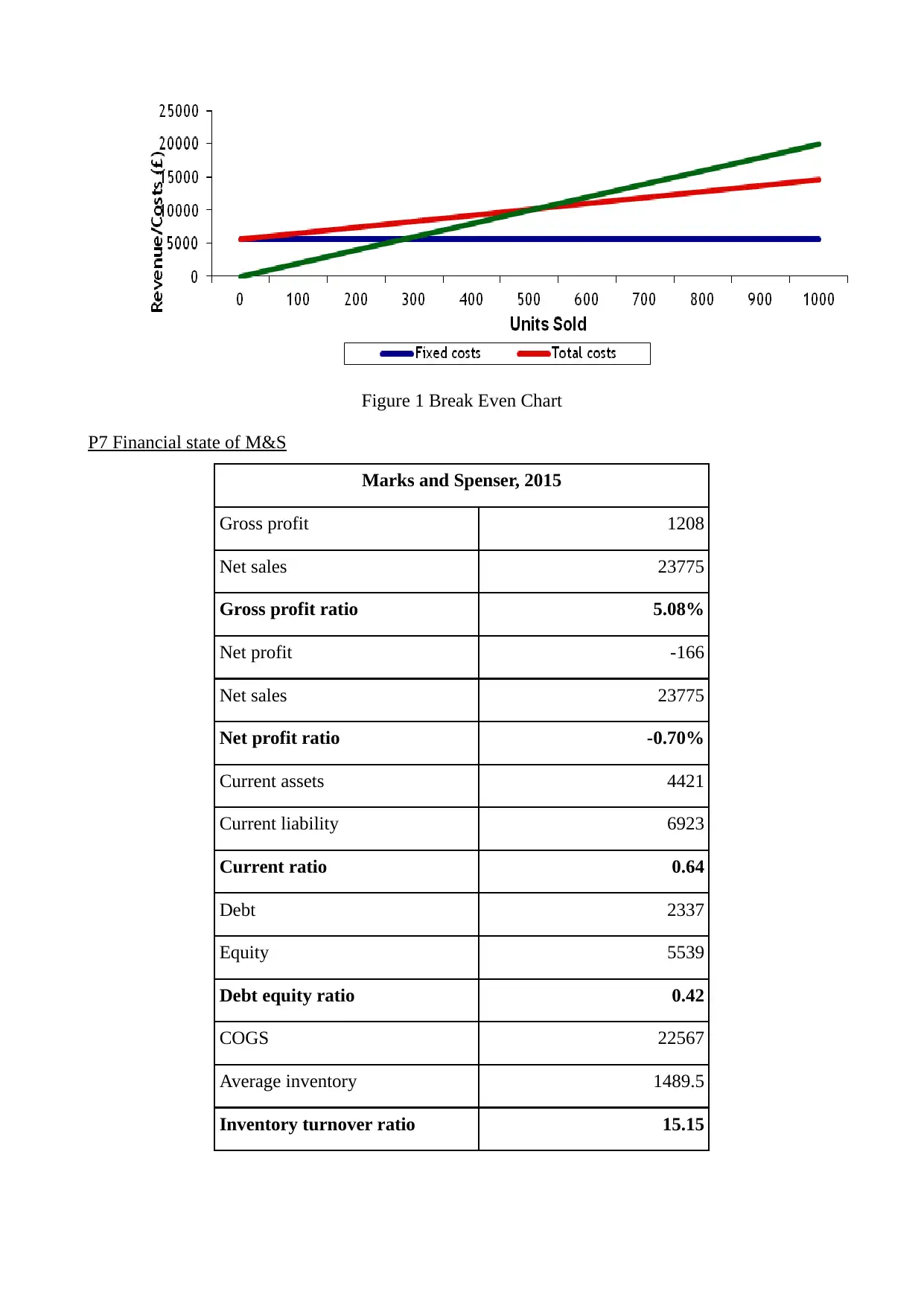
Figure 1 Break Even Chart
P7 Financial state of M&S
Marks and Spenser, 2015
Gross profit 1208
Net sales 23775
Gross profit ratio 5.08%
Net profit -166
Net sales 23775
Net profit ratio -0.70%
Current assets 4421
Current liability 6923
Current ratio 0.64
Debt 2337
Equity 5539
Debt equity ratio 0.42
COGS 22567
Average inventory 1489.5
Inventory turnover ratio 15.15
P7 Financial state of M&S
Marks and Spenser, 2015
Gross profit 1208
Net sales 23775
Gross profit ratio 5.08%
Net profit -166
Net sales 23775
Net profit ratio -0.70%
Current assets 4421
Current liability 6923
Current ratio 0.64
Debt 2337
Equity 5539
Debt equity ratio 0.42
COGS 22567
Average inventory 1489.5
Inventory turnover ratio 15.15
⊘ This is a preview!⊘
Do you want full access?
Subscribe today to unlock all pages.

Trusted by 1+ million students worldwide
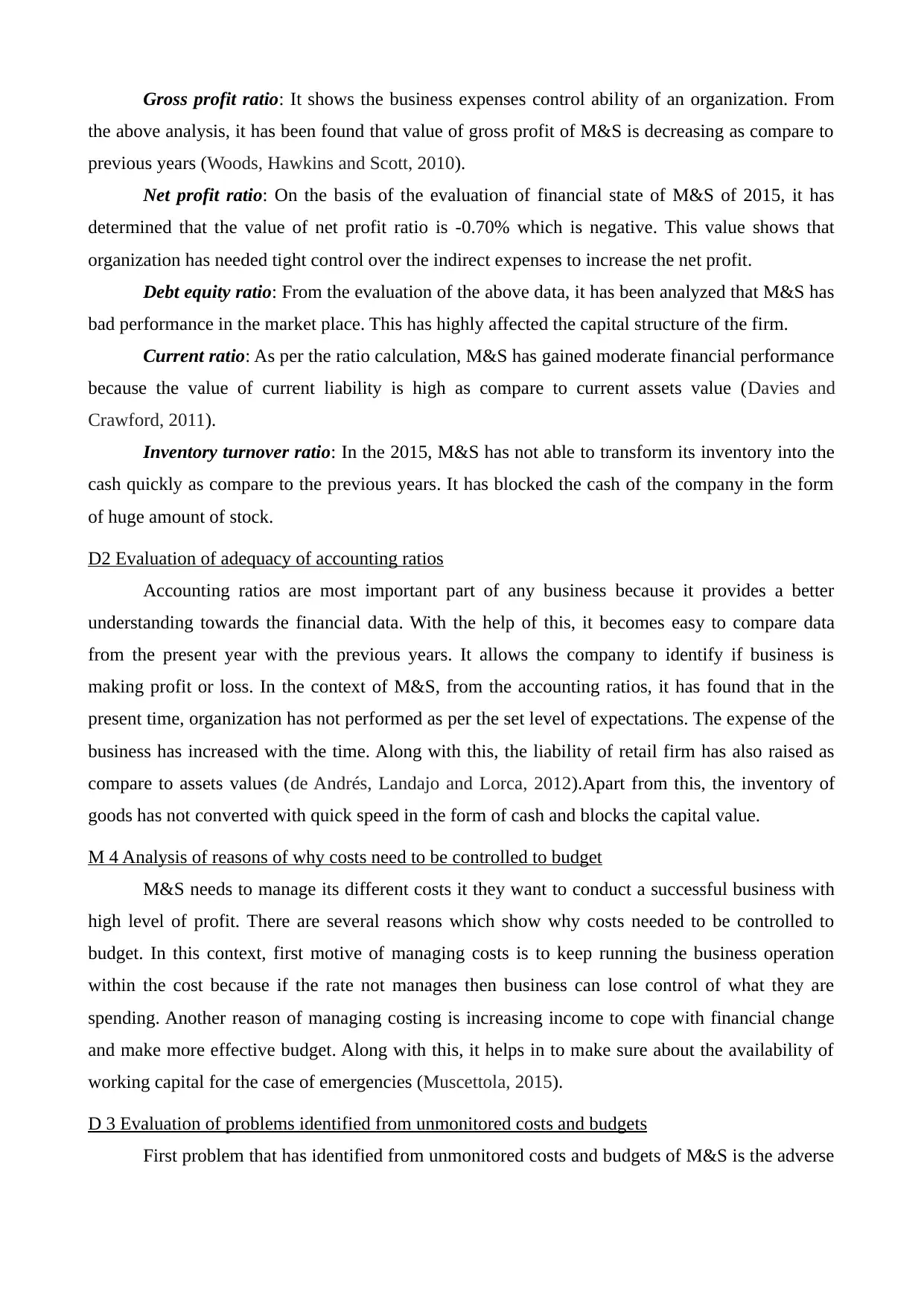
Gross profit ratio: It shows the business expenses control ability of an organization. From
the above analysis, it has been found that value of gross profit of M&S is decreasing as compare to
previous years (Woods, Hawkins and Scott, 2010).
Net profit ratio: On the basis of the evaluation of financial state of M&S of 2015, it has
determined that the value of net profit ratio is -0.70% which is negative. This value shows that
organization has needed tight control over the indirect expenses to increase the net profit.
Debt equity ratio: From the evaluation of the above data, it has been analyzed that M&S has
bad performance in the market place. This has highly affected the capital structure of the firm.
Current ratio: As per the ratio calculation, M&S has gained moderate financial performance
because the value of current liability is high as compare to current assets value (Davies and
Crawford, 2011).
Inventory turnover ratio: In the 2015, M&S has not able to transform its inventory into the
cash quickly as compare to the previous years. It has blocked the cash of the company in the form
of huge amount of stock.
D2 Evaluation of adequacy of accounting ratios
Accounting ratios are most important part of any business because it provides a better
understanding towards the financial data. With the help of this, it becomes easy to compare data
from the present year with the previous years. It allows the company to identify if business is
making profit or loss. In the context of M&S, from the accounting ratios, it has found that in the
present time, organization has not performed as per the set level of expectations. The expense of the
business has increased with the time. Along with this, the liability of retail firm has also raised as
compare to assets values (de Andrés, Landajo and Lorca, 2012).Apart from this, the inventory of
goods has not converted with quick speed in the form of cash and blocks the capital value.
M 4 Analysis of reasons of why costs need to be controlled to budget
M&S needs to manage its different costs it they want to conduct a successful business with
high level of profit. There are several reasons which show why costs needed to be controlled to
budget. In this context, first motive of managing costs is to keep running the business operation
within the cost because if the rate not manages then business can lose control of what they are
spending. Another reason of managing costing is increasing income to cope with financial change
and make more effective budget. Along with this, it helps in to make sure about the availability of
working capital for the case of emergencies (Muscettola, 2015).
D 3 Evaluation of problems identified from unmonitored costs and budgets
First problem that has identified from unmonitored costs and budgets of M&S is the adverse
the above analysis, it has been found that value of gross profit of M&S is decreasing as compare to
previous years (Woods, Hawkins and Scott, 2010).
Net profit ratio: On the basis of the evaluation of financial state of M&S of 2015, it has
determined that the value of net profit ratio is -0.70% which is negative. This value shows that
organization has needed tight control over the indirect expenses to increase the net profit.
Debt equity ratio: From the evaluation of the above data, it has been analyzed that M&S has
bad performance in the market place. This has highly affected the capital structure of the firm.
Current ratio: As per the ratio calculation, M&S has gained moderate financial performance
because the value of current liability is high as compare to current assets value (Davies and
Crawford, 2011).
Inventory turnover ratio: In the 2015, M&S has not able to transform its inventory into the
cash quickly as compare to the previous years. It has blocked the cash of the company in the form
of huge amount of stock.
D2 Evaluation of adequacy of accounting ratios
Accounting ratios are most important part of any business because it provides a better
understanding towards the financial data. With the help of this, it becomes easy to compare data
from the present year with the previous years. It allows the company to identify if business is
making profit or loss. In the context of M&S, from the accounting ratios, it has found that in the
present time, organization has not performed as per the set level of expectations. The expense of the
business has increased with the time. Along with this, the liability of retail firm has also raised as
compare to assets values (de Andrés, Landajo and Lorca, 2012).Apart from this, the inventory of
goods has not converted with quick speed in the form of cash and blocks the capital value.
M 4 Analysis of reasons of why costs need to be controlled to budget
M&S needs to manage its different costs it they want to conduct a successful business with
high level of profit. There are several reasons which show why costs needed to be controlled to
budget. In this context, first motive of managing costs is to keep running the business operation
within the cost because if the rate not manages then business can lose control of what they are
spending. Another reason of managing costing is increasing income to cope with financial change
and make more effective budget. Along with this, it helps in to make sure about the availability of
working capital for the case of emergencies (Muscettola, 2015).
D 3 Evaluation of problems identified from unmonitored costs and budgets
First problem that has identified from unmonitored costs and budgets of M&S is the adverse
Paraphrase This Document
Need a fresh take? Get an instant paraphrase of this document with our AI Paraphraser
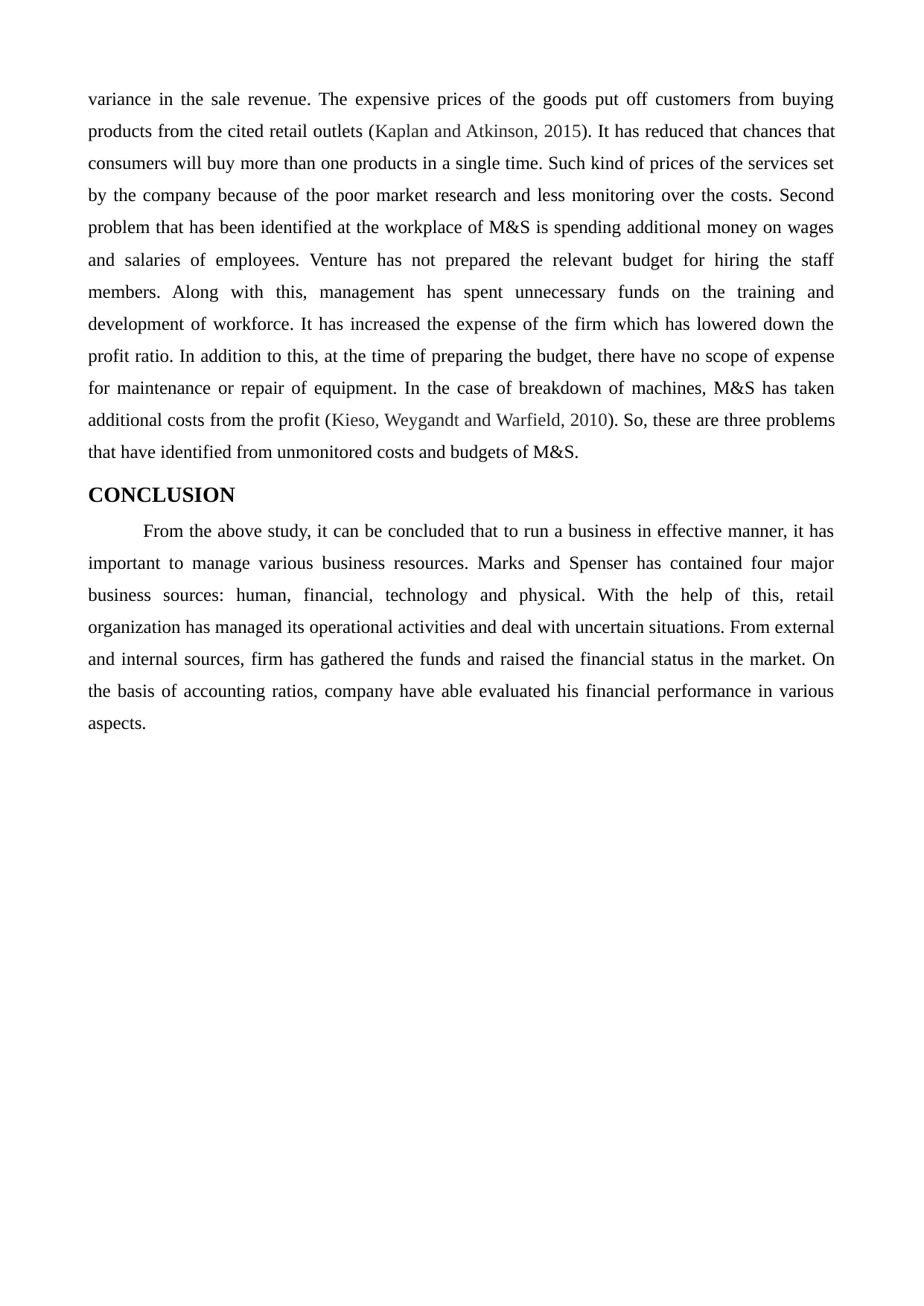
variance in the sale revenue. The expensive prices of the goods put off customers from buying
products from the cited retail outlets (Kaplan and Atkinson, 2015). It has reduced that chances that
consumers will buy more than one products in a single time. Such kind of prices of the services set
by the company because of the poor market research and less monitoring over the costs. Second
problem that has been identified at the workplace of M&S is spending additional money on wages
and salaries of employees. Venture has not prepared the relevant budget for hiring the staff
members. Along with this, management has spent unnecessary funds on the training and
development of workforce. It has increased the expense of the firm which has lowered down the
profit ratio. In addition to this, at the time of preparing the budget, there have no scope of expense
for maintenance or repair of equipment. In the case of breakdown of machines, M&S has taken
additional costs from the profit (Kieso, Weygandt and Warfield, 2010). So, these are three problems
that have identified from unmonitored costs and budgets of M&S.
CONCLUSION
From the above study, it can be concluded that to run a business in effective manner, it has
important to manage various business resources. Marks and Spenser has contained four major
business sources: human, financial, technology and physical. With the help of this, retail
organization has managed its operational activities and deal with uncertain situations. From external
and internal sources, firm has gathered the funds and raised the financial status in the market. On
the basis of accounting ratios, company have able evaluated his financial performance in various
aspects.
products from the cited retail outlets (Kaplan and Atkinson, 2015). It has reduced that chances that
consumers will buy more than one products in a single time. Such kind of prices of the services set
by the company because of the poor market research and less monitoring over the costs. Second
problem that has been identified at the workplace of M&S is spending additional money on wages
and salaries of employees. Venture has not prepared the relevant budget for hiring the staff
members. Along with this, management has spent unnecessary funds on the training and
development of workforce. It has increased the expense of the firm which has lowered down the
profit ratio. In addition to this, at the time of preparing the budget, there have no scope of expense
for maintenance or repair of equipment. In the case of breakdown of machines, M&S has taken
additional costs from the profit (Kieso, Weygandt and Warfield, 2010). So, these are three problems
that have identified from unmonitored costs and budgets of M&S.
CONCLUSION
From the above study, it can be concluded that to run a business in effective manner, it has
important to manage various business resources. Marks and Spenser has contained four major
business sources: human, financial, technology and physical. With the help of this, retail
organization has managed its operational activities and deal with uncertain situations. From external
and internal sources, firm has gathered the funds and raised the financial status in the market. On
the basis of accounting ratios, company have able evaluated his financial performance in various
aspects.

REFERENCES
Books and Journals
Abecassis‐Moedas, C., Ben Mahmoud‐Jouini, S., Dell'Era, C., Manceau, D. and Verganti, R., 2012.
Key Resources and Internationalization Modes of Creative Knowledge‐Intensive Business
Services: The Case of Design Consultancies. Creativity and innovation management. 21(3).
pp.315-331.
Bae, J., Rowley, C. and Sohn, T.W. eds., 2012. Managing Korean business: Organization, culture,
human resources and change. Routledge.
Baxter, R., 2012. How can business buyers attract sellers' resources?: Empirical evidence for
preferred customer treatment from suppliers. Industrial Marketing Management. 41(8).
pp.1249-1258.
Booker, L.D., Detlor, B. and Serenko, A., 2012. Factors affecting the adoption of online library
resources by business students. Journal of the American Society for Information Science and
Technology. 63(12). pp.2503-2520.
Callen, J.L. and Segal, D., 2010. A variance decomposition primer for accounting research. Journal
of accounting, auditing & finance. 25(1). pp.121-142.
Christensen, H.B., Nikolaev, V.V. and Wittenberg‐Moerman, R., 2016. Accounting information in
financial contracting: The incomplete contract theory perspective. Journal of Accounting
Research. 54(2). pp.397-435.
Davies, T. and Crawford, I., 2011. Business accounting and finance. Pearson.
de Andrés, J., Landajo, M. and Lorca, P., 2012. Bankruptcy prediction models based on multinorm
analysis: An alternative to accounting ratios.Knowledge-Based Systems. 30. pp.67-77.
Kaplan, R.S. and Atkinson, A.A., 2015. Advanced management accounting. PHI Learning.
Kieso, D.E., Weygandt, J.J. and Warfield, T.D., 2010. Intermediate accounting: IFRS edition. John
Wiley & Sons.
Korunka, C., Kessler, A., Frank, H. and Lueger, M., 2010. Personal characteristics, resources, and
environment as predictors of business survival. Journal of Occupational and Organizational
Psychology. 83(4). pp.1025-1051.
Macintosh, N.B. and Quattrone, P., 2010. Management accounting and control systems: An
organizational and sociological approach. John Wiley & Sons.
Mallah, S. and Bansal, N.K., 2010. Allocation of energy resources for power generation in India:
business as usual and energy efficiency. Energy Policy. 38(2). pp.1059-1066.
Muscettola, M., 2015. Predictive Ability of Accounting Ratio for Bankruptcy.Journal of Applied
Books and Journals
Abecassis‐Moedas, C., Ben Mahmoud‐Jouini, S., Dell'Era, C., Manceau, D. and Verganti, R., 2012.
Key Resources and Internationalization Modes of Creative Knowledge‐Intensive Business
Services: The Case of Design Consultancies. Creativity and innovation management. 21(3).
pp.315-331.
Bae, J., Rowley, C. and Sohn, T.W. eds., 2012. Managing Korean business: Organization, culture,
human resources and change. Routledge.
Baxter, R., 2012. How can business buyers attract sellers' resources?: Empirical evidence for
preferred customer treatment from suppliers. Industrial Marketing Management. 41(8).
pp.1249-1258.
Booker, L.D., Detlor, B. and Serenko, A., 2012. Factors affecting the adoption of online library
resources by business students. Journal of the American Society for Information Science and
Technology. 63(12). pp.2503-2520.
Callen, J.L. and Segal, D., 2010. A variance decomposition primer for accounting research. Journal
of accounting, auditing & finance. 25(1). pp.121-142.
Christensen, H.B., Nikolaev, V.V. and Wittenberg‐Moerman, R., 2016. Accounting information in
financial contracting: The incomplete contract theory perspective. Journal of Accounting
Research. 54(2). pp.397-435.
Davies, T. and Crawford, I., 2011. Business accounting and finance. Pearson.
de Andrés, J., Landajo, M. and Lorca, P., 2012. Bankruptcy prediction models based on multinorm
analysis: An alternative to accounting ratios.Knowledge-Based Systems. 30. pp.67-77.
Kaplan, R.S. and Atkinson, A.A., 2015. Advanced management accounting. PHI Learning.
Kieso, D.E., Weygandt, J.J. and Warfield, T.D., 2010. Intermediate accounting: IFRS edition. John
Wiley & Sons.
Korunka, C., Kessler, A., Frank, H. and Lueger, M., 2010. Personal characteristics, resources, and
environment as predictors of business survival. Journal of Occupational and Organizational
Psychology. 83(4). pp.1025-1051.
Macintosh, N.B. and Quattrone, P., 2010. Management accounting and control systems: An
organizational and sociological approach. John Wiley & Sons.
Mallah, S. and Bansal, N.K., 2010. Allocation of energy resources for power generation in India:
business as usual and energy efficiency. Energy Policy. 38(2). pp.1059-1066.
Muscettola, M., 2015. Predictive Ability of Accounting Ratio for Bankruptcy.Journal of Applied
⊘ This is a preview!⊘
Do you want full access?
Subscribe today to unlock all pages.

Trusted by 1+ million students worldwide
1 out of 13
Related Documents
Your All-in-One AI-Powered Toolkit for Academic Success.
+13062052269
info@desklib.com
Available 24*7 on WhatsApp / Email
![[object Object]](/_next/static/media/star-bottom.7253800d.svg)
Unlock your academic potential
Copyright © 2020–2025 A2Z Services. All Rights Reserved. Developed and managed by ZUCOL.





